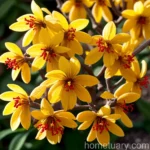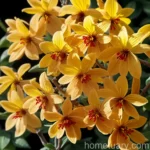Witch Hazel (Hamamelis x intermedia ‘Bernstein’)
In the world of ornamental shrubs, Witch Hazel (Hamamelis) stands out for its unique beauty and remarkable uses. One particularly stunning cultivar, known as ‘Bernstein,’ is celebrated for its vibrant blooms and various horticultural properties. This article will delve into the intricacies of Witch Hazel, shedding light on its culture, uses, care requirements, and much more. Whether you are a gardening enthusiast, a botanist, or someone seeking natural remedies, this comprehensive guide to Witch Hazel (Hamamelis x intermedia ‘Bernstein’) is sure to captivate your interest.
What is Witch Hazel (Hamamelis x intermedia ‘Bernstein’)?
Witch Hazel is a deciduous shrub renowned for its exquisite, fragrant flowers that bloom in late winter to early spring, often when little else is in bloom. The cultivar ‘Bernstein’ is a particular variety of Hamamelis x intermedia, revered for its splendid golden yellow flowers. This hybrid species is a cross between Hamamelis japonica and Hamamelis mollis, combining the best traits of both parent species.
The ‘Bernstein’ cultivar typically reaches a height and width of 12 to 15 feet, forming a large, spreading shrub. It bears broadly oval, dark green leaves with a serrated margin, offering visual interest even outside the blooming season. As fall approaches, the foliage transforms into vibrant shades of orange and red, adding to the plant’s appeal.
Key Takeaways – Witch Hazel (Hamamelis x intermedia ‘Bernstein’)
Before delving further into the nuances of Witch Hazel (Hamamelis x intermedia ‘Bernstein’), let’s explore the key takeaways pertaining to this captivating plant:
- Scientific Name: Hamamelis x intermedia ‘Bernstein’
- Common Name: Witch Hazel ‘Bernstein’
- Family: Hamamelidaceae
- Blooming Season: Late winter to early spring
- Color: Golden yellow flowers, dark green leaves turning orange and red in fall
- Uses: Ornamental, medicinal, skincare
Culture
Water
Witch Hazel, including the ‘Bernstein’ cultivar, thrives in moderately moist, well-drained soil. While it can tolerate short periods of drought once established, consistent watering, especially during dry spells, is crucial for promoting healthy growth and prolific flowering. However, it is important to avoid waterlogging the soil, as Witch Hazel is susceptible to root rot under excessively wet conditions.
Sunlight
This deciduous shrub flourishes in partial shade to full sun, making it adaptable to various light conditions. Placing it in a location with dappled sunlight or partial shade during the hottest part of the day is especially beneficial in regions with intense summers.
Fertilizer
Witch Hazel generally does not require excessive fertilization. A balanced, slow-release fertilizer applied in early spring can provide the necessary nutrients for robust growth and abundant flowering. It’s important to follow the product instructions and avoid over-fertilizing, which can lead to excessive vegetative growth at the expense of flowering.
Soil
The ‘Bernstein’ cultivar, like other Witch Hazel varieties, thrives in humus-rich, slightly acidic soil. A pH range of 5.5 to 6.5 is considered ideal for optimal growth and flowering. Furthermore, ensuring good soil drainage is crucial to prevent waterlogging and subsequent root rot.
Pruning
Pruning Witch Hazel, including the ‘Bernstein’ cultivar, is generally minimal. Any necessary pruning to shape the plant or remove damaged or crossing branches is best carried out just after the flowering period. This timing allows for the removal of spent flowers and the reshaping of the shrub without compromising the following year’s bloom.
Propagation
Witch Hazel can be propagated through various methods, including seed sowing and softwood cuttings. It’s worth noting that seeds may take several years to mature into flowering plants, whereas softwood cuttings can yield new, identical plants more rapidly. Propagation is often best carried out in a well-prepared, well-draining growing medium under controlled conditions to enhance the chances of success.
Container Popularity
While Witch Hazel, particularly the ‘Bernstein’ cultivar, is predominantly grown in gardens and landscapes, it can also thrive in large containers. This allows individuals with limited garden space to enjoy the beauty and fragrance of Witch Hazel on patios, balconies, and other outdoor areas. When growing in containers, it’s crucial to select a spacious, well-draining pot and ensure adequate moisture and nutrient availability.
Common Diseases
Witch Hazel, including the ‘Bernstein’ cultivar, is generally resilient to major disease issues when grown in suitable conditions. However, it can occasionally be affected by common ornamental shrub diseases such as powdery mildew, leaf spot, and blight. Providing proper air circulation, avoiding overhead watering, and promptly removing and disposing of any affected plant material can help prevent and manage these diseases.
Disease Diagnosis
When diagnosing potential diseases in Witch Hazel, careful inspection of the foliage, stems, and flowers is crucial. Look for characteristic symptoms such as powdery white patches (indicative of powdery mildew), dark spots on the leaves (indicative of leaf spot), or sudden wilting and dieback (indicative of blights). In case of uncertainty, consulting a plant pathologist or horticulturist can aid in accurate disease identification and subsequent management strategies.
Common Pests
Witch Hazel, including the ‘Bernstein’ cultivar, is relatively resistant to pest infestations. However, it can occasionally be targeted by common garden pests such as aphids, spider mites, and scale insects. Regular monitoring of the plant for signs of pest activity, such as distorted growth, stippled leaves, or visible insects, can aid in early pest detection and the implementation of appropriate control measures.
Botanist’s Tips
To ensure the optimal growth and flowering of Witch Hazel, here are some essential tips to consider:
- Mulching: Applying a layer of organic mulch around the base of the shrub helps conserve soil moisture, deter weeds, and maintain a cool root environment.
- Air Circulation: Providing ample space between plants and avoiding overcrowding allows for better air circulation, reducing the risk of foliar diseases.
- Winter Protection: In regions with harsh winters, providing a layer of mulch around the base of the shrub and covering it with burlap can protect the plant from winter desiccation and temperature fluctuations.
- Regular Inspection: Periodic examination of the shrub for signs of disease, pest activity, or nutrient deficiencies enables timely intervention and maintenance.
Fun Facts
- Witch Hazel has a long history of traditional medicinal uses, including its application as a natural astringent and for soothing various skin conditions.
- The twigs of Witch Hazel have been historically used for dowsing or water divining, a folklore practice of locating underground water sources.
- Witch Hazel extracts are commonly incorporated into skincare and cosmetic products for their toning and cleansing properties.
Intrigued by the allure of Witch Hazel? Explore further with the following resources and information.
Links to External Resources
- American Horticultural Society: Witch Hazel
- Royal Horticultural Society: Witch Hazel Cultivation
- University of Maryland Medical Center: Witch Hazel
Witch Hazel represents a captivating blend of ornamental beauty, historical significance, and practical uses. Whether you are drawn to its stunning blooms, intrigued by its folklore, or seeking natural remedies, the ‘Bernstein’ cultivar and other Witch Hazel varieties offer a wealth of fascination and utility. Embracing this remarkable shrub in your garden not only adds visual splendor but also connects you to a rich tapestry of cultural, medicinal, and horticultural heritage.















